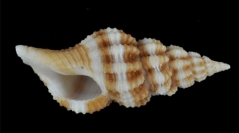The genus Pseudolatirus Bellardi, 1884, with the Miocene type species Fusus bilineatus Hörnes, 1853, has been used for 13 Miocene to Early Pleistocene fossil species and eight Recent species and has traditionally been placed in the fasciolariid subfamily Peristerniinae Tryon, 1880. Although the fossil species are apparently peristerniines, the Recent species were in their majority suspected to be most closely related to Granulifusus Kuroda & Habe, 1954 in the subfamily Fusininae Wrigley, 1927. Their close affinity was confirmed by the molecular phylogenetic analysis of Couto et al. (2016). In the molecular phylogenetic section we present a more detailed analysis of the relationships of 10 Recent Pseudolatirus-like species, erect two new fusinine genera, Okutanius gen. nov. (type species Fusolatirus kuroseanus Okutani, 1975) and Vermeijius gen. nov. (type species Pseudolatirus pallidus Kuroda & Habe, 1961). Five species are described as new for science, three of them are based on sequenced specimens (Granulifusus annae sp. nov., G. norfolkensis sp. nov., Okutanius ellenae gen. et sp. nov.) and two (G. tatianae sp. nov., G. guidoi sp. nov.) are attributed to Granulifusus on the basis of conchological similarities to sequenced species. New data on radular morphology is presented for examined species.


 European Journal of Taxonomy
2018 (433) - Pages 1-57
European Journal of Taxonomy
2018 (433) - Pages 1-57